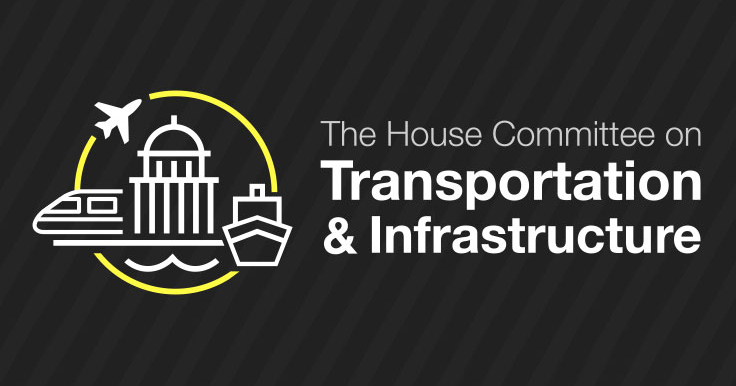Washington, D.C. — As the 117th Congress dives into its work—and committee assignments and leadership roles have been finalized—we now know more about the key congressional players for rail policy. Here’s a quick look at some of those changes, the new faces, and a refresher on some of the policy issues on our radar.
House Transportation and Infrastructure Committee

The key committee for rail policy in the House will continue with the same leadership at the top: Rep. Peter DeFazio (OR-4) as chairman and Rep. Sam Graves (MO-6) as ranking member.
There will be a leadership change in the rail subcommittee, however, with Rep. Donald Payne (NJ-10) ascending to chair following the departure of Dan Lipinski of Illinois. Congressman Payne, who has served on the Transportation and Infrastructure Committee since 2017, has signaled his commitment to shoring up the nation’s rail system in the wake of the pandemic. “It is a great honor and privilege to chair such an important subcommittee,” he said in a statement.
Seventeen new members will join the Transportation and Infrastructure Committee in total, 10 Republicans and seven Democrats. Here’s a rundown of the new additions:
- Jake Auchincloss (D-MA-4)
- Carolyn Bourdeaux (D-GA-7)
- Tim Burchett (R-TN-2)
- Michael Guest (R-MS-3)
- Dusty Johnson (R-SD-AL)
- Jeff Van Drew (R-NJ-2)
- Carlos Gimenez (R-FL-26)
- Kaiali’I Kahele (D-HI-2)
- Nancy Mace (R-SC-1)
- Nicole Malliotakis (R-NY-11)
- Seth Moulton (D-MA-6)
- Troy Nehls (R-TX-22)
- Marie Newman (D-IL-4)
- Beth Van Duyne (R-TX-24)
- Michelle Steel (R-CA-48)
- Marilyn Strickland (D-WA-10)
- Nikema Williams (D-GA-5)
Senate Committee on Commerce, Science and Transportation
With a 50-50 tie in the Senate, Democrats gain the majority by virtue of Vice President Kamala Harris’s constitutional role as President of the Senate. Leadership on Senate Commerce—the primary committee affecting railroads in the Senate—will be familiar but flipped, with previous ranking member Sen. Maria Cantwell (D-WA) now serving as chair and Sen. Roger Wicker (R-MS) as ranking member. New additions to the committee include Sen. John Hickenlooper (D-CO), Sen. Raphael Warnock (D-GA) and Sen. Cynthia Lummis (R-WY).

Sen. Cantwell, the first woman ever to chair the committee, stressed the importance of transportation legislation in the context of COVID recovery. “We’re right now in the midst of another transportation package to help revive our economy and help continue to work,” she said in a statement.
Also of note is a leadership change on the Senate Appropriations transportation subcommittee as Sen. Brian Schatz (D-HI) takes the reins as chair. He has highlighted transit and alternative transportation modes in the place of car-centric projects.
Issues
Federal authorization of surface transportation programs expires later this year, as Congress passed a temporary extension last fall. There seems to be bipartisan desire to pass a robust infrastructure program this year to help the country continue to recover from the economic damage of the pandemic.
While these bills often focus more on highway infrastructure, the House and Senate passed very different bills last year and the House bill, in particular, contained several controversial policies affecting freight railroads. The Association of American Railroads notes that its two overarching priorities for a reauthorization are that it, 1) “Pursue bipartisan solutions and infrastructure investments to accelerate our nation’s economic recovery,” and 2), “Avoid controversial policy riders that would hinder economic growth.”
Among the specific proposals championed by freight railroads include restoring the Highway Trust Fund (HTF) to a user-based fund. A vehicle miles traveled fee system has gained traction on both sides of the aisle, particularly for commercial vehicles like heavy trucks that cause the lion’s share of highway damage but typically underpay their share of roadway costs. Mileage-based fees “can lead to more equitable and efficient use of roadways,” according to the Government Accountability Office. From the perspective of railroads, which pay for their infrastructure themselves, user-based fees would better support modal equity.
In any reauthorization, railroads would also like to see increased funding for highway-rail grade crossings, continued funding for Amtrak and other passenger rail, reforms to make the project permitting system more efficient, and the facilitation of technology development equally across all modes of transportation.
Conversely, allowing heavier or longer trucks, or passing operational mandates that restrict innovation and rail competitiveness, would hinder the movement of freight by rail, according to the AAR. Arbitrary restrictions “limit the ability of environmentally-friendly railroads to meet our nation’s current and future freight transportation demand.”
The Bottom Line
Hopes are high that “Amtrak Joe” will bring renewed momentum and true commitment to infrastructure investment. Having emphasized transportation as a top priority for his Administration, Biden has proposed a $2 trillion infrastructure plan and started to hold meetings to advance the ball. While all parties seem to be pushing for early action, the reality of the legislative process makes enacting a bill during the first half of the year a challenge. Of course, we will continue to provide updates and alert you to provisions affecting freight railroads throughout the process.


